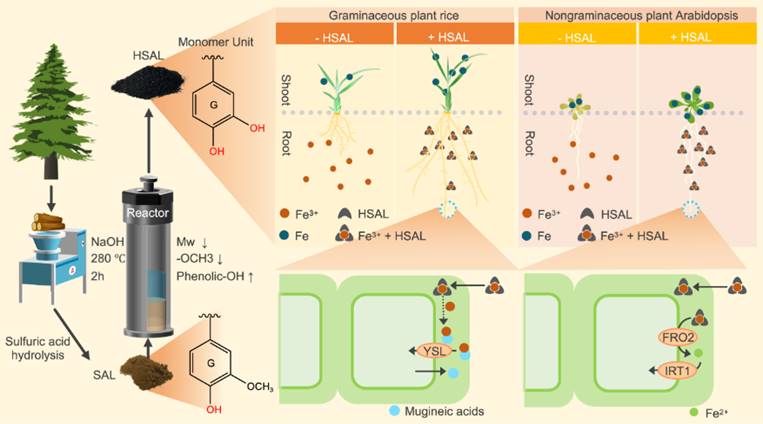Zhejiang University Scientists Uncover Lignin-Derived Material for Enhancing Plant Growth
Lignin, Earth’s most abundant natural aromatic polymer, constitutes nearly one-third of the carbon reserves in the natural world and serves as one of the major components of plant cell walls. In the biomass refinery sector, lignin is commonly discharged as a waste product in the biorefining system. On the other hand, micronutrient deficiencies in staple crops contribute to widespread micronutrient malnutrition, known as hidden hunger, affecting approximately one third of the global population. Fertilizer additives offer a potential solution by enhancing the bioavailability of mineral nutrients in staple crops. However, these additives not only incur high costs but also pose an environmental threat due to their non-biodegradable nature.
Recently, a collaborative endeavor between two research teams was led by Prof. LI Baohai at the College of Environmental and Resource Science, Zhejiang University, and Prof. Yasuyuki Matsushita from Nagoya University / Tokyo University of Agriculture and Technology in Japan. Their collaborative research yielded a groundbreaking publication titled “A lignin-derived material improves plant nutrient bioavailability and growth through its metal chelating capacity” in the prestigious journal Nature Communications. This pioneering study unveils a novel mechanism where a lignin-derived material enhances nutrient bioavailability by modifying its metal chelating ability, therefore promoting root growth in plants to improve plant adaptability and biomass production.

Schematic diagram for HSAL synthesis, structure and its capacity for enhancing iron bioavailability to increase root length and plant biomass.
In their research, Prof. LI Baohai and his colleagues developed a cost-effective, innovative type of natural polymer fertilizer additive based on sulfuric acid lignin, a waste lignin derived from biomass refineries. On the strength of previous research, substantial quantities of sulfuric acid lignin, generated via the acid hydrolysis of lignocellulosic biomass in biorefinery, were converted into water-soluble lignin fragments called hydrothermal sulfuric acid lignin (HSAL) through an alkaline hydrothermal reaction. This hydrothermal reaction not only depolymerized SAL but also considerably reduced methoxy groups while increasing the proportion of phenolic hydroxyl groups within lignin. Consequently, HSAL acquired a substantial metal ion chelating capacity. Researchers also observed that HSAL can enhance the bioavailability of various plant nutrients by improving its metal chelating capacity, thereby stimulating root growth and increasing plant biomass. Moreover, HSAL can improve the bioavailability of essential metal nutrients such as iron, calcium and zinc in both monocot and dicot plants such as rice, and Arabidopsis thaliana.
Remarkably, the HSAL-mediated improvement in iron bioavailability rivals that of the well-known but not-biodegradable metal chelator—ethylenediaminetetraacetic acid (EDTA). In contrast, HSAL, derived from natural lignin, undergoes biodegradation in the soil. This renders HSAL a promising and sustainable alternative to substitute for synthetic chelating agents. It not only has the potential to promote the profitability and sustainability of biorefineries, but also facilitates increased carbon sequestration for a more environmentally friendly future.

